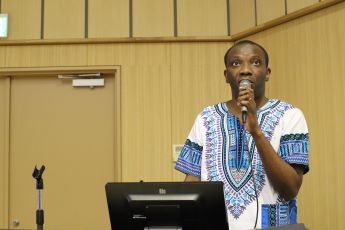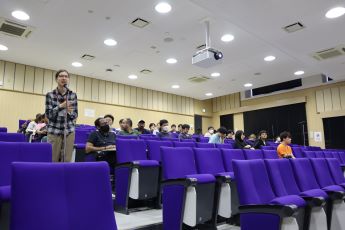- Home
- Student Activity
- Student Monthly Progress #4
We had a fourth Student Monthly Progress on June 23rd, 2023.
This time, 4 students gave presentations on their research.
【Presenter】
1. SHIMIZU Kotaro:Laboratory of Wildlife Biology and Medicine
<Tick burden of brown bear (Ursus arctos yesoensis) and sika deer (Cervus nippon yesoensis) in Hokkaido, Japan>
2. KATO Mira:Laboratory of Biochemistry
<Maternal vitamin A deficiency suppresses browning of white adipose tissue in offspring>
3. MUNYEKU Yannick Bazitama:Division of Global Epidemiology
<Characterization of Human Tibrovirus Envelope Glycoproteins>
4. SOE NYEIN CHAN:Laboratory of Toxicology
<Immobilization of lead in soil by chicken manure and its efficacy on a mouse model>
【Chair】
INTARUCK Kittiya:Division of Molecular Pathobiology
SUWANTHADA Pondpan:Division of Bioresources
❖Chairperson's Report❖
There are 4 students who presented their research in this meeting.
First presenter is SHIMIZU Kotaro from the Laboratory of Wildlife Biology and Medicine. He presented his study on the burden of ticks in brown bear and sika deer in Hokkaido. The reason why he targeted these 2 wildlife species because they are large animal that can harbor numerous amounts of ticks. Moreover, brown bear and sika deer have wide territorial that are important for spreading of ticks and may relate to the risk of tick-borne diseases in humans.
Second, KATO Mira from the Laboratory of Biochemistry presented her study on suppression of the browning mechanism of white adipose tissue in the offspring due to maternal vitamin A deficiency. Browning of white adipose tissue is the mechanism for lipolysis and lacking this mechanism may lead to obesity problem in humans and animals. This study demonstrated that deficiencies of vitamin A in maternal mice can suppress browning of white adipose tissue in their offspring and may lead to obesity in mice.
The third presenter is MUNYEKU Yannick Bazitama from the Laboratory of Global Epidemiology. His research focuses on characterization of human Tibrovirus envelope glycoproteins (GP). He generated from virus-like particle bearing GP of 4 tibrovirus strains, immunized mice and examined neutralizing antibodies. In addition, he used these pseudoviruses to evaluate zoonotic potential by determining attachment factor of this virus and cell tropism.
The last presenter is SOE NYEIN CHAN from the Laboratory of Toxicology. He presented his research on immobilization of lead contamination in soil by chicken manure and evaluate its efficacy to decrease lead uptake in a mouse model. His study demonstrated that chicken manure acts as lead immobilizer and might have potential to reduce contamination of lead into the body of mice.
This meeting provided an insight of many research fields including ecology, physiology, virology, and toxicology. It was a great opportunity for all graduate students to learn various kinds of research through their class mate’s studies.
%20mini.jpg)
mini.jpg)
mini.jpg)

mini.jpg)

